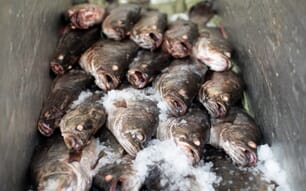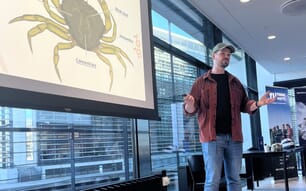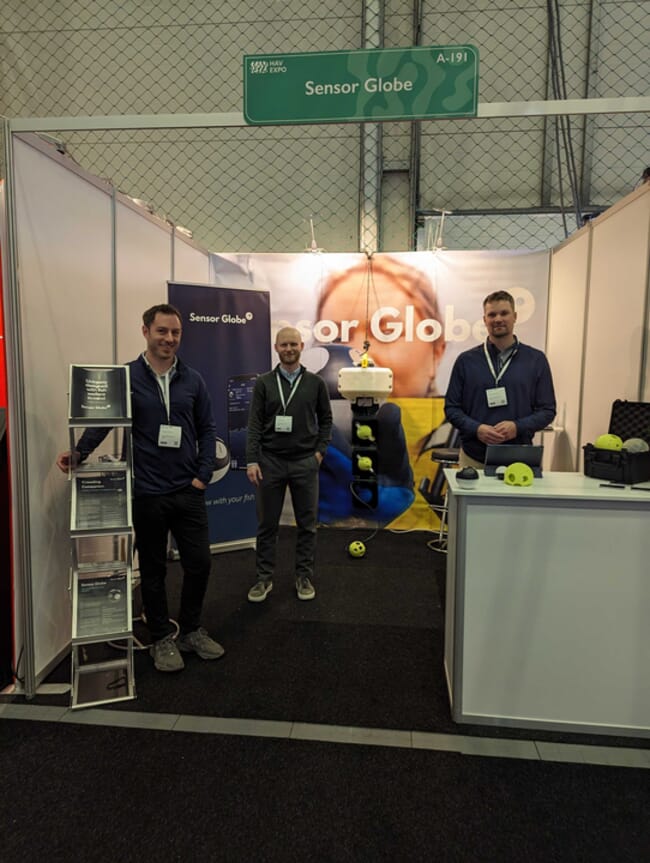
© Sensor Globe
For Sheamus MacDonald, co-founder and CEO of Sensor Globe*, aquaculture is more than a business – it’s a legacy.
“I grew up in rural Nova Scotia, in a commercial fishing family. My father, grandfather and everyone before him were active commercial fishermen. So that was always my interest,” he reflects.
That lifelong connection to the sea laid the foundation for Sensor Globe, a company aiming to transform how fish health and handling are understood across the seafood supply chain.
The startup has developed mobile sensor platforms that track environmental and handling conditions in real time — particularly during the most stressful moments in a fish’s life: transport, treatment and harvest. The company’s key innovation is a robust, waterproof spherical sensor that travels through aquaculture systems alongside live fish, collecting critical data on everything from oxygen levels to acceleration and pressure shocks.
The inspiration came from frustration. MacDonald and his co-founder, Aleksandr Stabenow – a who had been friends since university – were working on business automation and traceability tools for the seafood industry.
“In building that, we saw a unique way to identify the traceability of a product and correlate it to the environmental conditions it was exposed to,” says MacDonald.
But they struggled to find a suitable system.
“We got frustrated with the sensor technologies that were on the market. We wanted something mobile, something that could actually move with the [seafood] product as it goes from environment to environment. And that's where we conceptualised Sensor Globe,” he explains.
From concept to commercialisation
The Sensor Globe device — a 95 mm sphere — is as tough as it is smart. It’s designed to pass through pumps, pipes and wellboats, just like the fish themselves. It collects up to 14 samples per second, measuring temperature, conductivity, pH, motion dynamics, dissolved oxygen, pressure and shock.
According to McDonald, what sets it apart isn’t just the breadth of what it measures – it’s where and when it collects that data.
“As salmon are being moved during smolt transfers or treatment operations, the product goes through the same mechanical infrastructure, collecting data on exactly what the fish are exposed to,” he explains.
That capability is key. One of the most stressful events in aquaculture is crowding – when fish are concentrated in their pens to be counted, treated or harvested. Sensor Globe developed a wireless, floating sensor array for this purpose, complete with an alert system for the farmers.
“We can have multiple units at varying depths, customisable to the user. It floats in the centre of the biomass, collecting data on what the fish are exposed to in real time,” MacDonald explains.
“There’s a light on the buoy: green is good, yellow is trending towards an issue, and red means there’s a problem,” he adds.
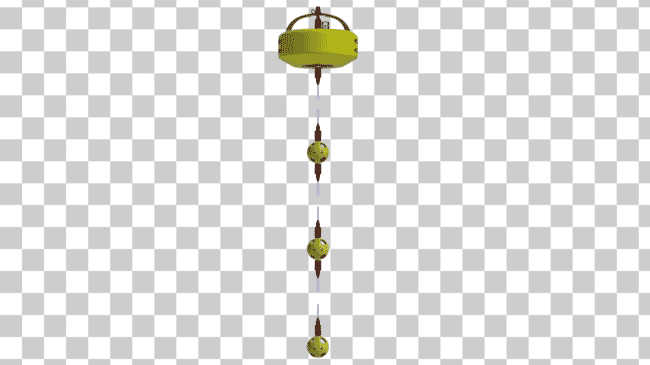
© Sensor Globe
A pre-emptive tool in a stressful system
Crowding, MacDonald explains, requires a delicate balance. “You have 120,000 or 200,000 fish swimming around in a tight body of water. There’s less water availability, and oxygen-consuming animals are continually consuming that. High CO₂ levels can lead to meat gaping or even heart rupture – conditions not always reported.”
Sensor Globe helps operators intervene early. “If they’re crowding the fish and everything’s green, they can maintain those levels. If it’s yellow or red, they can slow down the crowding, release the net, or add oxygen to the water,” says MacDonald.
That real-time visibility has been eye-opening for customers. “We've been able to uncover what's actually happening beneath the surface,” he adds. “One bad crowding can reduce their health for a long period. After using our product for one run through, they can quickly identify a specific area in their operation that needs adjustment — and it immediately improves their bottom line.”
Building with and for the Industry
Rather than disrupting existing monitoring systems, Sensor Globe sees itself as filling a critical gap. “We’re not trying to replace sensors in the cages. We’re an operational tool. I like to think we’re carving out a space: becoming leaders in fish handling and movement,” MacDonald says.
This positioning has helped the company gain traction with both large salmon producers and smaller operations across multiple geographies. With deployments in Norway, Canada, the UK, Australia and Chile, Sensor Globe now has over 100 units in the field and MacDonald claims that farmers are swiftly recouping the cost of the system.
“There’s an ROI [return on investment] basically after the first use,” he notes.
They’ve also gained attention in adjacent sectors like Norwegian king crab and land-based systems.
As Sebastian Gjertsen, who joined the team to help it scale in Norway, adds: “King crab can be kept alive for weeks in small spaces. The sensors are used to track water quality throughout live transport from northern to southern Norway and into Europe and Asia.”
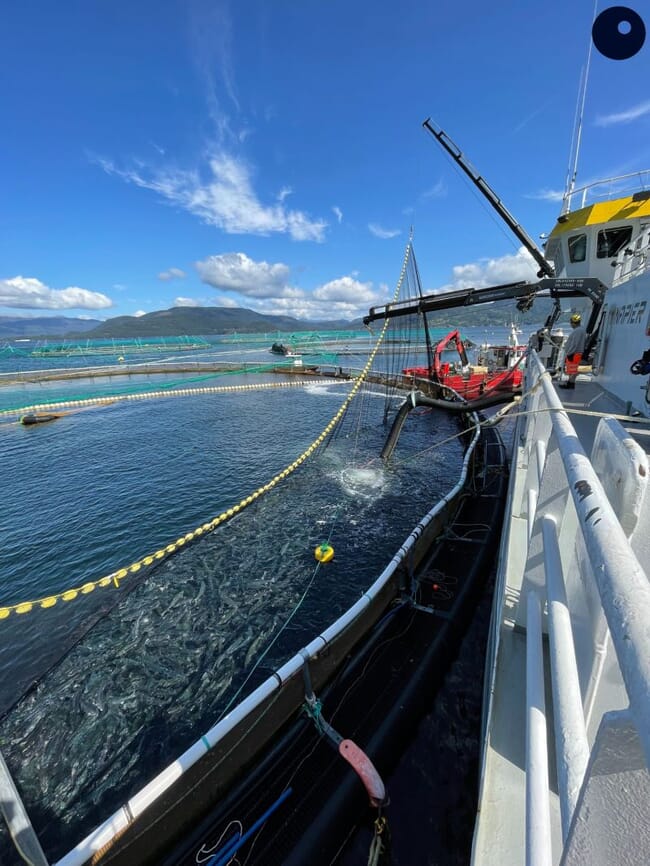
© Sensor Globe
Wider applications
It’s not just farmers who can benefit from Sensor Globe – the company also works with wellboat operators, equipment manufacturers and delousing system providers.
“We’ve done a lot of work to calibrate systems and help developers understand, at certain flow rates, if their devices are going to work,” says MacDonald. “We’re not just working with the farmers – we’re spread out through the entire value chain.”
Researchers and regulators are interested too. The company has collaborated with scientists and was highlighted by Norway’s animal welfare authorities as a tool to help reduce mortality and improve welfare. “We’re production agnostic — land-based or sea-based – equipment. We’re filling a data gap that hadn’t been filled before,” MacDonald emphasises.
Scaling, funding, and the road ahead
Four years into development, Sensor Globe has commercialised two product lines and is now shifting focus toward advanced analytics. With over 10,000 data files collected, the team’s next challenge is turning that raw information into predictive insights.
“We’re learning how to translate large amounts of data into actionable insights quickly,” MacDonald says. “Our next phase is more on the data side – strengthening our team and enabling forward-looking recommendations.”
As a result, Sensor Globe is preparing for expansion. Backed by aquaculture accelerator Hatch Blue, the company is now in the process of closing a $1.5 million round — its first dilutive funding — to grow its team and accelerate commercialisation, particularly in Norway and the UK.
The business model is straightforward: hardware sales, supported by maintenance packages. Units are designed to be user-friendly and durable, with a five-year technical lifespan.
“We’re not a heavy infrastructure product. We ship it out, they deploy it, they do the maintenance – it’s user-controlled,” MacDonald reflects.
While their sensors might be small MacDonald has big ambitions.
“The goal is to become leaders in fish movement and handling,” he says. “They’re stressful operations – for the fish and the operators. We want to be an easy-to-use platform that helps systemise and digitise these processes.”
He points to the evolving workforce as a reason why this matters. “The demographic of the industry is changing. A lot of the knowledge built up over 40 years isn’t documented. We’re trying to take that knowledge and put it into a data model that anyone can use – even if they’re new to the farm site.”
“We want to give fish a resume of everything they’ve experienced from start to finish,” adds MacDonald. “So our customers can understand blind spots, make informed decisions, and grow – both their fish and their business.”
*Sensor Globe is part of Hatch's investment portfolio, but The Fish Site retains editorial independence.

© Sensor Globe



